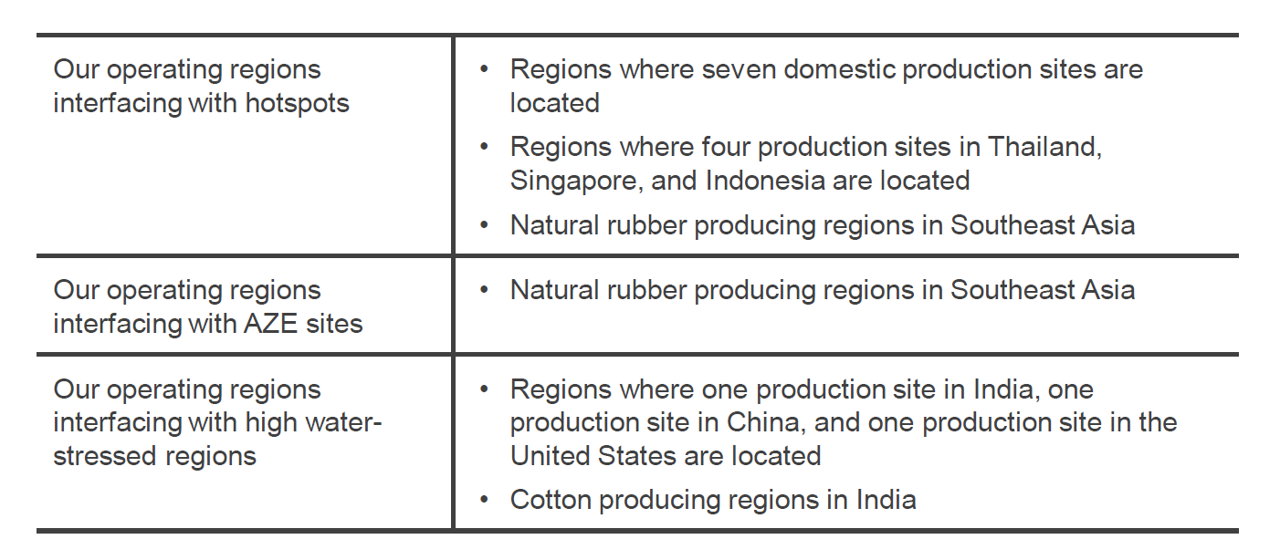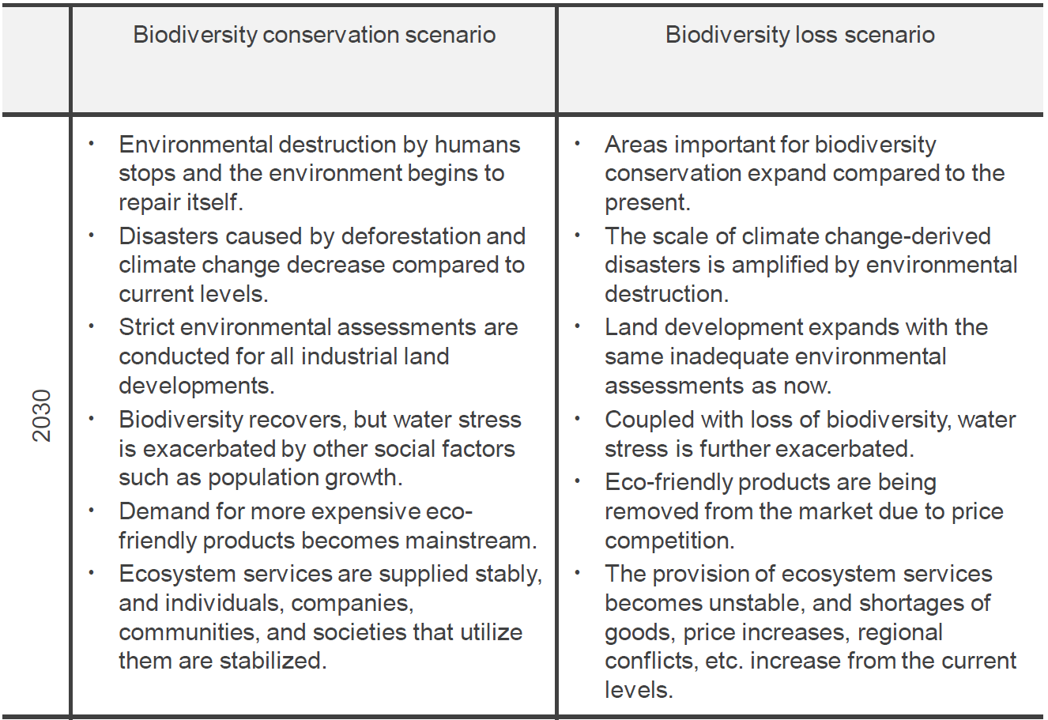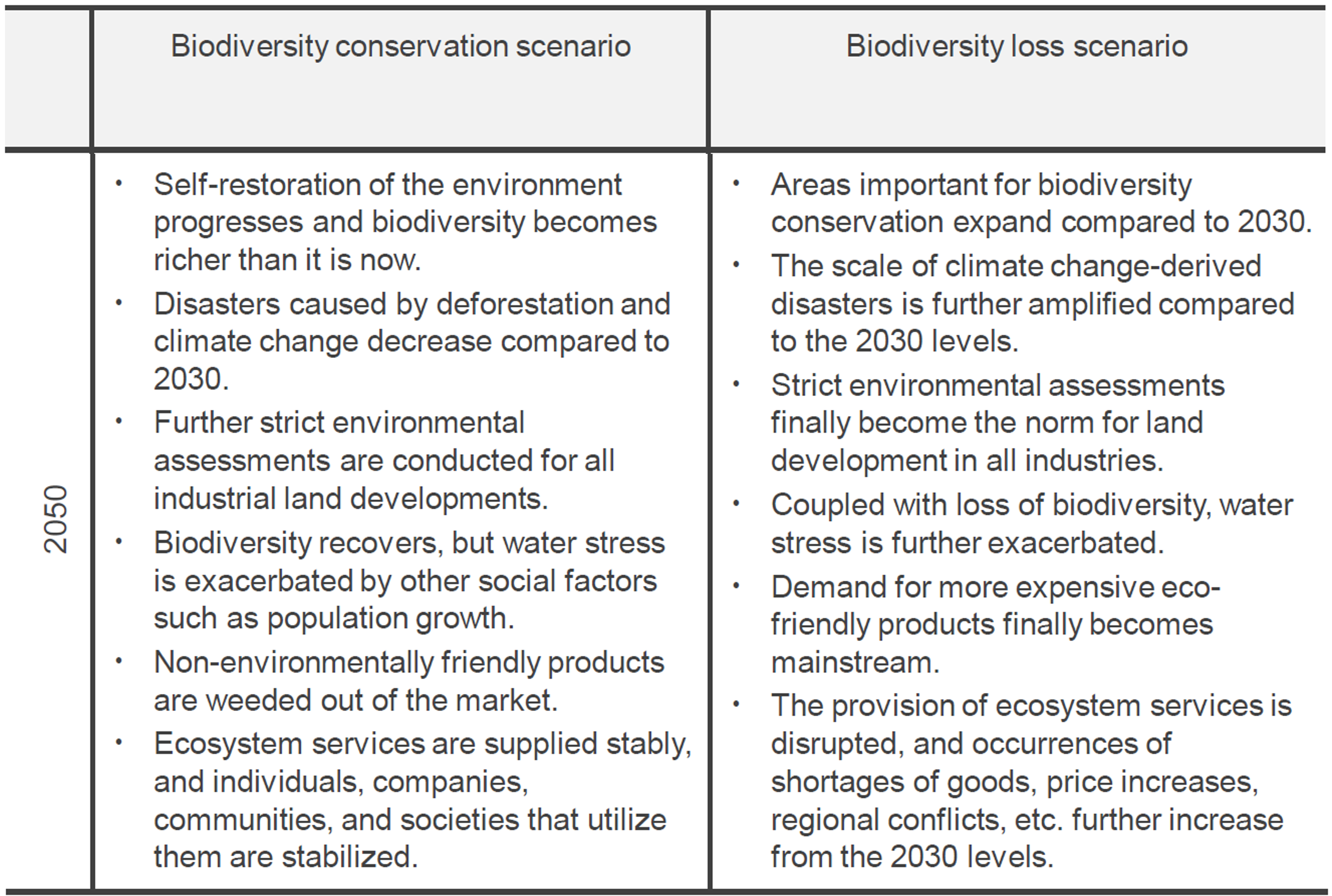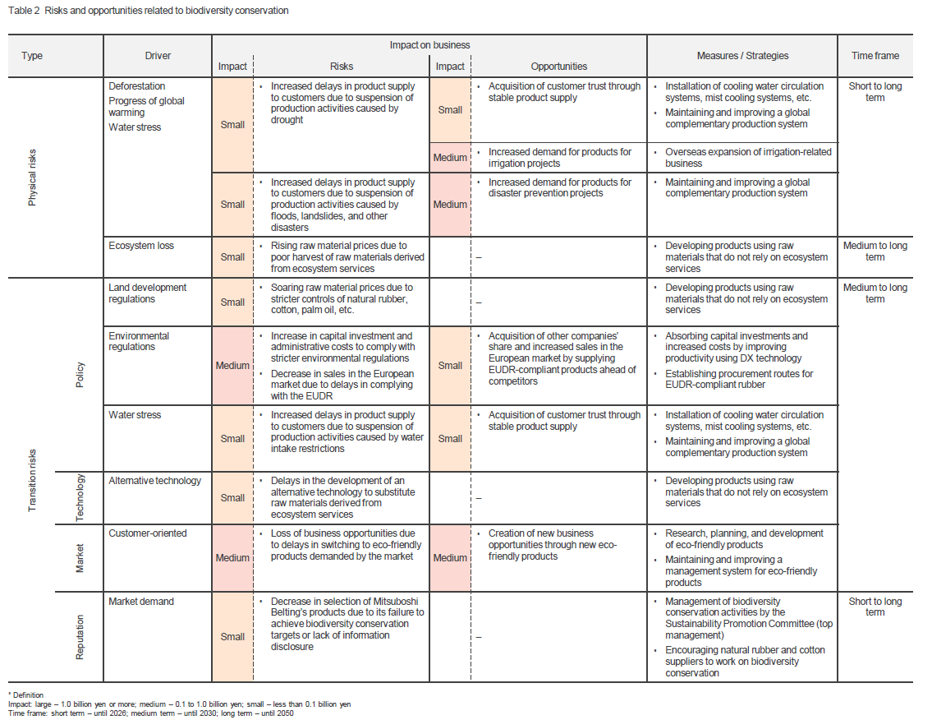Environment
Initiatives for Biodiversity Conservation
Basic approach
Biodiversity is rapidly being lost due to global warming, environmental pollution, overexploitation, overfishing, and other factors caused by human activities, and ecosystems are in crisis. If we fail to take action now, the entire society will suffer severe damage in the future due to inability to enjoy ecosystem services, and we will not be able to realize a “sustainable society.” The Mitsuboshi Belting Group has been working to reduce CO2 emissions in order to curb global warming, but we also recognize that biodiversity loss is a risk of equal importance and urgency to global warming for society as a whole.
We have identified “biodiversity conservation” as one of our materiality. We have set specific KPIs for each of the issues, including water resources conservation, and have been working on various activities.
Strategy
The Sustainability Promotion Committee has identified risks and opportunities related to “biodiversity conservation” and assessed their impact on the Mitsuboshi Belting Group’s business activities, in accordance with the disclosure framework recommended by the TNFD, and has developed strategies and targets based on the impact assessment results.
Relationship between operating regions and nature
Our Group’s production sites use steam as a heat transfer medium and water as a refrigerant in the processing of rubber products. Without a sufficient amount of good quality fresh water supplied by nature, in no time we would be forced to suspend operations. In addition, natural rubber, cotton, oil processed from palm oil, etc. are used as non-petroleum-derived raw materials in the manufacture of rubber products, but if the supply of these materials is disrupted, we would have no choice but to rely on petroleum-derived raw materials, leading to increased risk of resource depletion. Furthermore, our Group’s main products -transmission belts and related products -are widely used in various industries, including agriculture, forestry, fishery, mining, semiconductors, automotive, electrical machinery, machinery, food and logistics. For these reasons, we recognize that our Group’s business activities depend not only on water and natural materials but also on many other ecosystem services.
We investigated, using ENCORE, the dependencies that the industry to which our Group belongs (sub-industry: automotive parts, tire & rubber / production process: parts manufacturing, tire & rubber) has on ecosystem services. The investigation results showed that there were no ecosystem services on which our industry depends at a Very High level, but that the dependency on “groundwater” and “surface water” was High.
Our Group’s production activities consume various resources, including energy (water and other natural resources), and emit waste, wastewater, exhaust gas, exhaust heat, noise, odors, etc., which have a significant impact on the natural environment. Among our industry’s impact drivers (impact factors) on ecosystem services identified by ENCORE, there were no Very High-level impact factors, but six High-level impact factors were identified: “disturbances to living,” “greenhouse gas emissions,” “soil pollution,” “waste,” “water pollution,” and “water consumption.”
Based on these results, the Group will continue to take concrete steps towards the sustainable use of natural capital and reduction of environmental impacts, including the efficient use of resources and product design that takes environmental impact mitigation into consideration.
- ENCORE (Exploring Natural Capital Opportunities, Risks and Exposure) is an online tool jointly developed by the Natural Capital Finance Alliance (NCFA), an international network of financial institutions, the United Nations Environment Programme World Conservation Monitoring Center (UNEP-WCMC), and other organizations. This tool helps organizations to explore their exposure to nature-related risk and to understand and assess their dependencies and impacts on nature.
We surveyed and identified the interface between the Mitsuboshi Belting Group’s operating regions (from the perspective of product life cycle) and important regions for biodiversity conservation. Specifically, as our operating regions, we selected (1) regions where the Mitsuboshi Belting Group’s 16 production sites are located, (2) regions where natural rubber and cotton, which are our raw materials, are produced, and (3) regions where crude oil, which is our raw material and energy source, is produced. For important regions for biodiversity conservation, we selected (1) regions called hotspots,*1where ecosystem integrity is being lost, (2) regions where endangered species need to be protected (AZE sites*2), and (3) high water-stressed regions.*3
We recognize that business activities at the Group’s sites have a significant impact on their respective local ecosystems due to water consumption, environmental pollution caused by wastewater, and emissions and waste discharged. More specifically, we believe that in the production of natural rubber, deforestation due to land use has a heavy impact on the ecosystem, while in the production of cotton, the water consumption required for cultivation and environmental pollution caused by pesticides have a heavy impact on the ecosystem. Issues related to the production of natural rubber and cotton have already been taken up as international environmental issues, and several initiatives have been launched to improve them. We believe that these issues should be given the highest priority in the Group’s business activities. Regarding water consumption, implementing water use reduction in production activities is important also for biodiversity conservation, as all of our production sites in Japan, where such activities are carried out, are located in biodiversity hotspots. We are determined to achieve the reduction target without fail.
- A hotspot is a region with more than 1,500 species of endemic vascular plants (seed plants and ferns) and where more than 70% of the native ecosystem has been altered.
- An AZE site is an area that holds the last remaining populations of 1,483 of the earth’s most threatened species, as disclosed by the Alliance for Zero Extinction biodiversity initiative.
- High water-stressed regions: Regions with a baseline water stress level that is classified as “extremely high” in the World Resource Institute’s Aqueduct Water Risk Atlas.
Scenario analysis, risks and opportunities, and strategy
We have identified risks and opportunities by taking into consideration the relationship between the regions in which the Mitsuboshi Belting Group operates and the important biodiversity regions, as well as the scenarios shown in Table 1 below. Table 2 summarizes the identified risks and opportunities and measures taken to address them. By examining information obtained from published biodiversity-related reports and the World Resource Institute’s Aqueduct, the Mitsuboshi Belting Group has created scenarios that describe what the natural environment and social situations will look like in 2030 and 2050.
Table 2 Risks and opportunities related to biodiversity conservation
Failure to develop eco-friendly products generates negative financial impact in the form of lost opportunities for new businesses as well as reduced demand for existing products. Just as products with large carbon footprints are removed from the market to address climate change, products that negatively impact biodiversity conservation will be removed from the market. In fact, in June 2023, the European Union Deforestation Regulation (EUDR) came into force. Under the EUDR, businesses are required to prove that their products are not linked to deforestation when exporting them to the EU market.
Meanwhile, irrigation projects in regions with high water stress are expected to become increasingly active in the future. Our company’s water-shielding sheets and installation services have already been widely used in irrigation projects in Japan, but at present, we have hardly been able to expand them into overseas high water-stressed regions. Utilizing the sales network for our main product, transmission belts, we will expand our business of watershielding sheets and installation services to high water-stressed regions.
Just like reducing, calculating, and disclosing CO2 emissions as a measure to address climate change, we believe that working to reduce water consumption and properly disclosing the status of reduction is also very important for our business activities. From our efforts to date, we have already confirmed that the use of recycled water through cooling water circulation systems is an effective measure to reduce water consumption. We will continue to actively install cooling water circulation systems to reduce water consumption.
- A regulation that aims to minimize the EU’s contribution to global deforestation and forest degradation. It covers seven commodities (cocoa, coffee, palm oil, rubber, soya, cattle and wood, and derivatives). This regulation prohibits any operators and traders from trading products linked to deforestation and forest degradation in the EU market and requires due diligence for them. The provisions of the EUDR will apply to small and medium-sized enterprises from June 30, 2025, and to other enterprises from December 30, 2024, and the sale of products that do not meet EUDR standards will be prohibited in the EU.
Targets
The Group has already completed the development of product specifications that do not use cotton or natural rubber. However, these products inevitably require the use of some non-renewable raw materials. In the context of resource depletion, cotton and natural rubber will continue to be raw materials that play a crucial role. In the future, we plan to encourage our cotton and natural rubber suppliers to conduct business activities that take biodiversity conservation into consideration, in accordance with the Procurement Guidelines formulated in FY2023. For targets regarding water resources, please refer to “Targets” in the section “Initiatives to Conserve Water Resources.”










